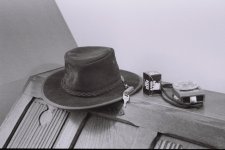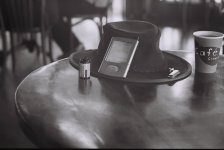mike goldberg
The Peaceful Pacific
OK guys & gals,
Here's the routine with HC-110 + Tmax 400:
I'm an early riser, so by 6-AM I had set out my graduates, poured chemicals and put these in the freezer for just a few minutes to cool down to 75f. Early in the morning in Jerusalem, the wash water is just under 80f.
So, it's pre-wash for 30 seconds...
I'm using my own adaptation of Covington's "Dilution E," which is 1:14. In a 2-reel stainless tank, I mix 30mL European HC-110 syrup with 430mL water. That's easy to remember 30 + 430 = 460. NOTE: I do this, even if I'm only developing one film. Why? If I'm developing 2 films at another time, I don't want to get all mixed up. With one film, I cut back on Time a bit.
Now, I know that higher dilutions are more economical. As I develop more B/W, I'll move in that direction. Even in Jerusalem, HC-110 is relatively cheap, and the Dilution above is what works.
So, this morning, it was 10 minutes at 75f, agitate the first 30 seconds, and then 2 turns of the tank... every 2 minutes.
Stop bath is plain water with agitation for 30 seconds.
Fixer is Ilford's liquid, mixed 1+9. Fixing time is 6 minutes.
Wash is for 10 minutes with filtered water; we've got a filter installed under the kitchen stainless steel sink. It's a good environment for film developing.
Drying is in a small bathroom, with an electric heater on its lowest setting. This takes around an hour in the summertime.
PROOF IN THE PUDDING: The negs are drying as I write, and they look about 10% more contrasty than last time. That's good, because in editing I had been boosting contrast a bit.
On to scans, and later today I'll post some test shots.
Comments welcome ;-)
Here's the routine with HC-110 + Tmax 400:
I'm an early riser, so by 6-AM I had set out my graduates, poured chemicals and put these in the freezer for just a few minutes to cool down to 75f. Early in the morning in Jerusalem, the wash water is just under 80f.
So, it's pre-wash for 30 seconds...
I'm using my own adaptation of Covington's "Dilution E," which is 1:14. In a 2-reel stainless tank, I mix 30mL European HC-110 syrup with 430mL water. That's easy to remember 30 + 430 = 460. NOTE: I do this, even if I'm only developing one film. Why? If I'm developing 2 films at another time, I don't want to get all mixed up. With one film, I cut back on Time a bit.
Now, I know that higher dilutions are more economical. As I develop more B/W, I'll move in that direction. Even in Jerusalem, HC-110 is relatively cheap, and the Dilution above is what works.
So, this morning, it was 10 minutes at 75f, agitate the first 30 seconds, and then 2 turns of the tank... every 2 minutes.
Stop bath is plain water with agitation for 30 seconds.
Fixer is Ilford's liquid, mixed 1+9. Fixing time is 6 minutes.
Wash is for 10 minutes with filtered water; we've got a filter installed under the kitchen stainless steel sink. It's a good environment for film developing.
Drying is in a small bathroom, with an electric heater on its lowest setting. This takes around an hour in the summertime.
PROOF IN THE PUDDING: The negs are drying as I write, and they look about 10% more contrasty than last time. That's good, because in editing I had been boosting contrast a bit.
On to scans, and later today I'll post some test shots.
Comments welcome ;-)
Last edited:
alexz
Well-known
Great Mike, eager to see your results...
It took me about 4 rolls of Tri-X to establish my approach to it and just 2 rolls of Tmax to get grips on the latter. I found Dev.Chart's development info to be right on for Tmax, while being off by 10-15% for Tri-X. So far my only developer is HC-110.
So, my approach to Tmax 400 (shot at 400) is Dill. H (twice as dilluted as B), 10 minutes at 20 deg.C, constant (slow) agitation during first 30 sec., then two turns per minute, stop-bath - just a few water bathes (water brought also to about 20 deg.C) agitated, fixer - Tetenal Superfix Plus, 1:3, 5 minutes (re-usable), final rinse
(Illford water-saving approach), 1 minute bath in Photoflo...that's it.
Contrary to opinions of may, I found Tmax to get processed quite easy, actually a bit easier then even Tri-X..however I didn't try yet pull or push Tmax, while Tri-X pulls from 200 very easy (haven't yet established my approach to Tri-X pushing to 800 and 1600, intend to do that).
It took me about 4 rolls of Tri-X to establish my approach to it and just 2 rolls of Tmax to get grips on the latter. I found Dev.Chart's development info to be right on for Tmax, while being off by 10-15% for Tri-X. So far my only developer is HC-110.
So, my approach to Tmax 400 (shot at 400) is Dill. H (twice as dilluted as B), 10 minutes at 20 deg.C, constant (slow) agitation during first 30 sec., then two turns per minute, stop-bath - just a few water bathes (water brought also to about 20 deg.C) agitated, fixer - Tetenal Superfix Plus, 1:3, 5 minutes (re-usable), final rinse
(Illford water-saving approach), 1 minute bath in Photoflo...that's it.
Contrary to opinions of may, I found Tmax to get processed quite easy, actually a bit easier then even Tri-X..however I didn't try yet pull or push Tmax, while Tri-X pulls from 200 very easy (haven't yet established my approach to Tri-X pushing to 800 and 1600, intend to do that).
mike goldberg
The Peaceful Pacific
Hi Alex,
Tho' you can push Tmax to 800, Tri-x is better for this.
QUESTIONS:
How's your grain pattern, when pushing Tri-x?
Where do you buy Tri-x?
Cheers, Mike
Tho' you can push Tmax to 800, Tri-x is better for this.
QUESTIONS:
How's your grain pattern, when pushing Tri-x?
Where do you buy Tri-x?
Cheers, Mike
mike goldberg
The Peaceful Pacific
Close Focus Test Shots, about 1.1 meters away from subject:
It was a short roll; the Tmax 400 was moved between 2 cameras [not such a great practice]. There were a few spaces, and a few negs overlapped
In both shots below, the Zorki-4 was tripod mounted, shots were bracketed, and those normally exposed, or 1-stop under, looked best. Both photos are full frame, and the pocket scissors was included, for occasional trimming of film leader.
- Hat & stuff on desk:
Fed 50/3.5 Collapsible, 1/30, wide open
The R/F was focused at the front of the hat; there was NO digital sharpening in Resizing.
- Hat & stuff in coffee bar:
J8 50/2 [black, mid-1970's], 1/125, f2.8
The R/F was focused on the coffee cup; there was light digital sharpening here, in Resizing.
NOTE: I'm a beta tester for ACDSee Pro 2.0, and have been doing this for several months. If I decide to go with the new version to be released after September 30th, I'll get a 30% discount for my Feedback given in the ACD Systems Forums.
Cheers, Mike
It was a short roll; the Tmax 400 was moved between 2 cameras [not such a great practice]. There were a few spaces, and a few negs overlapped
In both shots below, the Zorki-4 was tripod mounted, shots were bracketed, and those normally exposed, or 1-stop under, looked best. Both photos are full frame, and the pocket scissors was included, for occasional trimming of film leader.
- Hat & stuff on desk:
Fed 50/3.5 Collapsible, 1/30, wide open
The R/F was focused at the front of the hat; there was NO digital sharpening in Resizing.
- Hat & stuff in coffee bar:
J8 50/2 [black, mid-1970's], 1/125, f2.8
The R/F was focused on the coffee cup; there was light digital sharpening here, in Resizing.
NOTE: I'm a beta tester for ACDSee Pro 2.0, and have been doing this for several months. If I decide to go with the new version to be released after September 30th, I'll get a 30% discount for my Feedback given in the ACD Systems Forums.
Cheers, Mike
Attachments
Last edited:
alexz
Well-known
Mike, I only tried to push Tri-X once to 1600, used my regular HC-110 and tried to follow the advise of one of RFF fellows on his recommende dillution for Tri-X pushed to 1600. Unfotunately I managed to mess around with dillutions and mistakably used my regular H for the time and agitation approach he gave for his own dillution. Ended up with greatly exxagerated contrast, something that I personally do not consider as any success with pushing. Evaluating the grain wasn't really practical then, because the whole approach to development was wrong..
I intend to carefully establish my approach to pushing Tri-X to 800 and up to 1600 in near future, probably will sacrifice 3-4 rolls to get to the point....
However, I found Tri-X rull from 200 really well, and in fact, I can make equally good negs out of nominal 400 and pulled from 200 (with the same dillution H, same agitation regime, but the time shorter by 2.5 minutes for 200).
This is really handy for our sunny and hot days, when I prefer slower film to keep aperture reasonably open, but once approaching PM hours, would swith to 400 while still shooting the same film. very versitle and convenient.
Moreover, inspecting high-rez scans from Tri-X and Tmax both shoot at nominal 400, I could see very little difference in grain, on certain flat-surfaced objects, the grain was probably a bit smoother on Tmax, but yet again, no any major difference at all...
I intend to carefully establish my approach to pushing Tri-X to 800 and up to 1600 in near future, probably will sacrifice 3-4 rolls to get to the point....
However, I found Tri-X rull from 200 really well, and in fact, I can make equally good negs out of nominal 400 and pulled from 200 (with the same dillution H, same agitation regime, but the time shorter by 2.5 minutes for 200).
This is really handy for our sunny and hot days, when I prefer slower film to keep aperture reasonably open, but once approaching PM hours, would swith to 400 while still shooting the same film. very versitle and convenient.
Moreover, inspecting high-rez scans from Tri-X and Tmax both shoot at nominal 400, I could see very little difference in grain, on certain flat-surfaced objects, the grain was probably a bit smoother on Tmax, but yet again, no any major difference at all...
mike goldberg
The Peaceful Pacific
Hi Alex,
Fred Picker, an Ansel Adams Zone system type in Vermont, used to expose Tri-x at 200. Tri-x is a great film for pulling & pushing.
I don't think I would do well pulling Tmax 400 back to 200, and cutting back on development. Then, I'd have a contrast problem. In fact, for posting on flickr, I brightened up the Cafe Hillel hat shot a bit ;-)
http://www.flickr.com/photos/mikegoldberg/1320606580/
So let's keep in touch...
It seems that we are both "fine-tuning" our methodology.
Cheers, Mike
Fred Picker, an Ansel Adams Zone system type in Vermont, used to expose Tri-x at 200. Tri-x is a great film for pulling & pushing.
I don't think I would do well pulling Tmax 400 back to 200, and cutting back on development. Then, I'd have a contrast problem. In fact, for posting on flickr, I brightened up the Cafe Hillel hat shot a bit ;-)
http://www.flickr.com/photos/mikegoldberg/1320606580/
So let's keep in touch...
It seems that we are both "fine-tuning" our methodology.
Cheers, Mike
Share:


